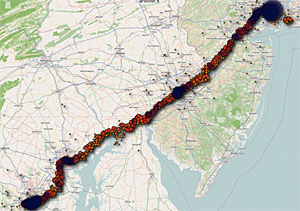By Alasdair Allan and Pete Warden
It’s now been a week since we published the iPhone tracking story, so it seemed a good time to cover what we’ve learned.
The fix
 Apple has just released a Q&A covering this problem and they will be fixing the issues we spotted with a software update. “The reason the iPhone stores so much data is a bug we uncovered,” Apple notes in the statement.
Apple has just released a Q&A covering this problem and they will be fixing the issues we spotted with a software update. “The reason the iPhone stores so much data is a bug we uncovered,” Apple notes in the statement.
Apple explains that nearby locations are pulled down from an Apple database and stored on the phone. These locations are from a “crowd-sourced database of Wi-Fi hotspot and cell tower data.” This matches the picture that was emerging from research. It explains why there’s lots of locations that don’t match towers, and also why the accuracy is within a few-hundred meters, since we’ve learned that “micro-cells” in urban areas are clustered closely together.
The Q&A explains the technical workings behind the log and reassures us that only anonymous data is sent back. Our conclusions still apply.
Apple doesn’t address our claim that this reveals sensitive information about your travels. At this point we’re just relieved to get an explanation and a fix, but people can examine their own data and decide for themselves how happy they would be sharing it with strangers.
Forensics
What Does Your iPhone Know About You? More Than You Think — Alexis Madrigal has written a fascinating follow-up piece covering the data that professionals can read from your phone. Using forensics tools like the Lantern program that Alex Levinson helped build, anyone with physical access to the device can construct a picture of the user’s life. It’s eye-opening what the “law enforcement, government, and corporate examiners” who purchase the system can uncover about your behavior.
The Tell-all telephone visualization also makes for thoughtful viewing. It’s built from details that a German politician forced his cell phone provider to share after it was caught storing six months of location data on its subscribers. I think one of the reasons that the iPhone Tracker application has had so much use is that it shows people their own data in an understandable way. Unfortunately, that means that similar information that’s harder to access behind a company’s firewall may not get the same scrutiny, just because it’s harder to show in a way that connects with people.
Uses for good
I’ve long been a fan of Geoloqi’s opt-in service for recording and sharing your travels, but several other projects in the same area have appeared in my inbox over the last few days. Maria Scileppi has created the Living Brushstroke project (see video below) to capture people’s movements at events, and turn the data into art. Intriguing and beautiful patterns emerge as people cross paths. It’s a very fresh way to look at our lives.
Related:
